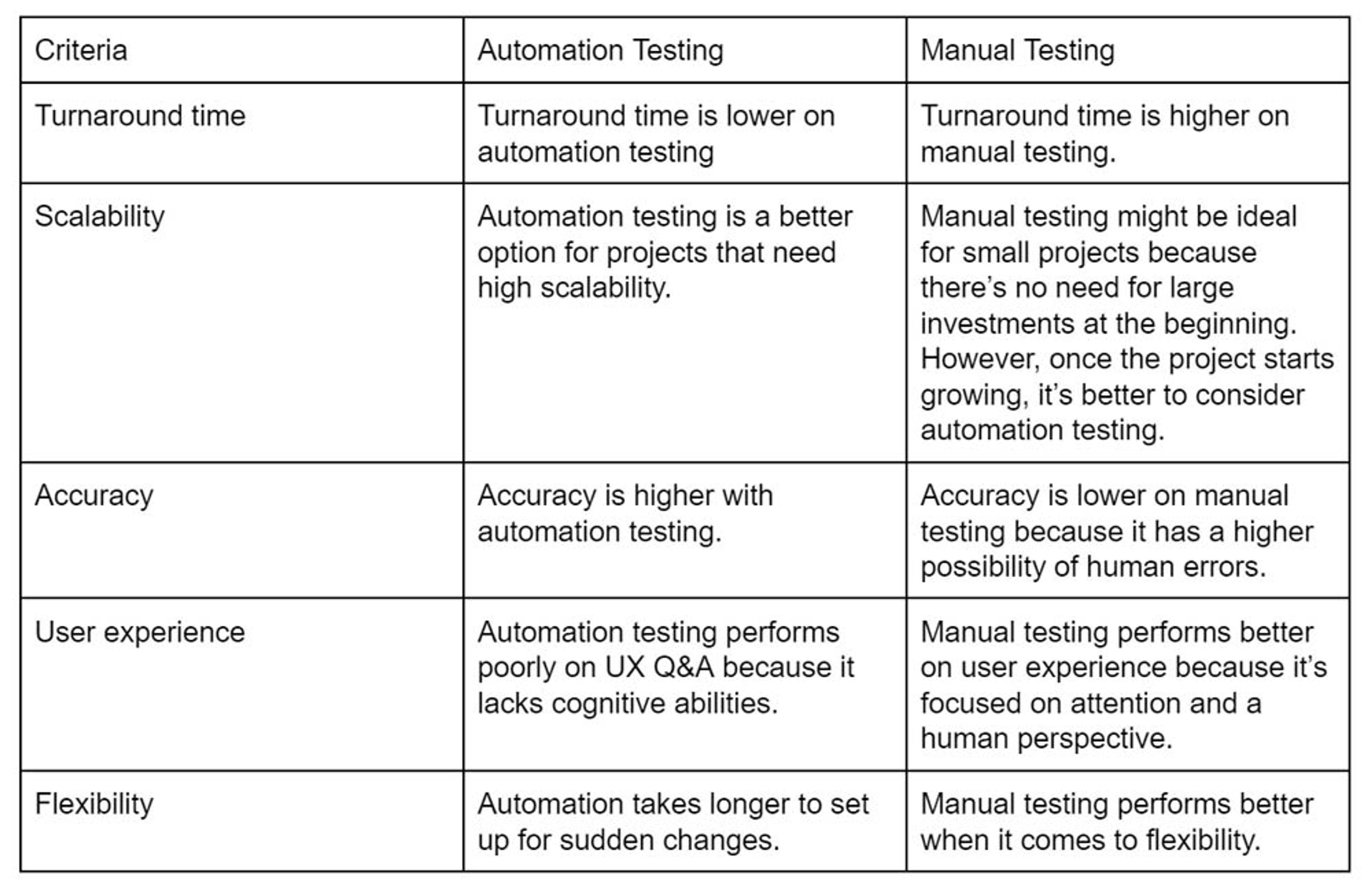Manual Q&A vs. Automated Testing: Which Option is Better for your Project?

When developing software, you may come across the decision of whether to conduct manual or automation testing. Q&A automation is scalable and has a high turnaround. In fact, the Q&A automation market size is expected to get a 15 percent compound annual growth rate by 2023, according to Global Market Insights.
However, it doesn’t mean that manual testing is no longer relevant in today’s software development industry. Today, we’ll show you some differences between both techniques and how you can use them to elevate your project.
What’s the Difference Between Manual vs. Automated Testing?
Manual testing is the process of evaluating software performance without using any tools or scripting. It requires a human tester to identify bugs, anomalies, and errors. Automated testing, on the other hand, consists of using frameworks, scripting, and tools to assess an application’s performance.
Manual Testing:
Manual testing is used to identify anomalies and discrepancies with the software expectations. The manual tester then follows a written test plan to evaluate test cases that help them recognize these bugs.
Automation Testing:
In automation testing, the specialist would set up frameworks and develop test scripts that automate user behavior required for evaluating software. They can also use automation tools. Since the turnaround of automation testing is pretty fast it was designed to speed up the development process.
Evolution of Testing
With the evolution of software development, we’ve increased the speed of the development process. New features are being released quicker, and this has come with an undeniable challenge for QA testers: keeping up with change. In a fast-development environment with manual testing, it is not uncommon to see discrepancies and anomalies in the software.
That’s how automation testing arose in the computer science industry. Automation testing has a faster turnaround time and more accuracy levels than manual Q&A. Therefore, it helps projects escalate faster with reduced possibilities of failure.
Can Automation Testing replace Manual Testing?
The simple answer is no. You should take this as a case-by-case scenario. The number one reason why automation testing will not replace manual Q&A is that automation testing lacks cognitive behavior. This makes it hard for these frameworks to catch up with things the end-user would.
Manual testing also offers more flexibility than automation Q&A, which is something to consider, especially when you’re dealing with complex issues.
Automation Testing Vs. Manual Q&A: Pros and Cons Comparison

Criteria Automation Testing Manual Testing Turnaround time Turnaround time is lower on automation testing Turnaround time is higher on manual testing. Scalability Automation testing is a better option for projects that need high scalability. Manual testing might be ideal for small projects because there’s no need for large investments at the beginning. However, once the project starts growing, it’s better to consider automation testing. Accuracy Accuracy is higher with automation testing. Accuracy is lower on manual testing because it has a higher possibility of human errors. User experience Automation testing performs poorly on UX Q&A because it lacks cognitive abilities. Manual testing performs better on user experience because it’s focused on attention and a human perspective. Flexibility Automation takes longer to set up for sudden changes. Manual testing performs better when it comes to flexibility.
Projects Where Automation Works Best
Automation testing works better on large projects that require high scalability and fast turnaround. This is because automation works better when there are repetitive tests to be run in the project. On the other hand, automation might also be ideal when human resources are scarce. This way, testers can automate repetitive tasks and focus on more relevant or complex assignments.

Projects Where Manual Automation Works Best
Manual automation works better when it comes to running UX testing because it has a human perspective. It is also ideal for short-term projects because automation requires a high investment and time to set up. Manual testing would allow the team to focus on minor features or minimal code.
Manual testing is also a great choice when flexibility is required. You can just work on minimal testing ideas and get immediate results, whereas, with automation, you’d need to spend a lot of time setting up the system.
Additionally, manual testing can perform better on more complex test scenarios. In fact, that might be one of the reasons why automation exists; so that testers can focus on high-level issues.
Having The Right Balance
Although it’s true that automation testing is becoming more sophisticated every day, we can’t say it’ll completely disrupt manual testing. In fact, the idea with Q&A automation is to remove repetitive tasks from testers’ shoulders, so they can focus on more relevant aspects of the project. This includes on-the-run testing, user experience, and complex testing.
For more in software testing, check out our article on **How I fell in love with test-driven development .**
Conclusion
Both automation and manual testing play vital roles in ensuring software quality, and each has its place depending on the project's scope and requirements. Automation excels in large-scale projects, where repetitive tasks can be streamlined for efficiency, and resources are scarce. It frees up human testers to concentrate on high-level, complex issues that demand a human touch.
On the other hand, manual testing is essential for short-term projects, those requiring flexibility, and scenarios where user experience or intricate functionality needs careful assessment. The key is striking the right balance: leveraging automation to handle routine checks while reserving manual testing for areas that benefit from creativity, judgment, and adaptability.
Ultimately, combining both approaches ensures a more comprehensive quality assurance process, maximizing efficiency while maintaining the integrity of the end product. For more information about Q&A process for software development, contact ScreamingBox .
ScreamingBox's digital product experts are ready to help you grow. What are you building now?
ScreamingBox provides quick turn-around and turnkey digital product development by leveraging the power of remote developers, designers, and strategists. We are able to deliver the scalability and flexibility of a digital agency while maintaining the competitive cost, friendliness and accountability of a freelancer. Efficient Pricing, High Quality and Senior Level Experience is the ScreamingBox result. Let's discuss how we can help with your development needs, please fill out the form below and we will contact you to set-up a call.